| Trading the Elliott Wave | | |  |
|  |
|
| |
| | | |
|
|
| | |
|
| | |
|
|
|
| The Elliott Wave Principle provides you with the most objective and disciplined method available for trading. Only a handful of patterns exist, sometimes easy to recognize especially in strong impulsive waves. The still validated patterns tell you where the market is heading, in what way (or structure) this will happen and under what circumstances the pattern will produce a stronger probability. Also the pattern will tell you when it is no longer valid due to the occurrence of an intolerable price action. This makes it possible to exactly determine your entry and exit points, which is an outstanding characteristic of the Elliott Wave Principle. The key to forecasting markets with ELWAVE lies in determining the probabilities of alternative scenarios. If you find several alternative counts pointing in the same direction, you have found an excellent trading opportunity. Some people, mainly those who can not successfully apply the Elliott Wave Principle themselves, will tell you either it is too complex and subjective or that the waves don?t exists at all, suggesting the market follows a random pattern. Obviously the Elliott Wave Principle can get very complex- especially in corrective waves- since you will have to look for patterns, which contain patterns, which contain patterns etc. etc. But it will never lose its objectivity if you apply the rules and guidelines. The only problem is that sometimes it is not totally clear if the internal structure of a wave is a 3 wave or a 5 wave. In that case you will have to determine alternatives for both internal wave structures and look for other confirmations, such as channels, indicators and Fibonacci ratios. Below we mention the key steps for Elliott Wave analysis and supply basic trading patterns to search for. |
| | | |
|
|
| 2. General directives for trading :: top :: |
|
| | |
|
|
|
| Now you can use the Automatic Analysis, to trade profitably. The more probable an outcome the better the opportunities. The more the alternatives point in the same direction the more certain that the market will move accordingly.
The Automatic analysis will generate an ever objective and consistent wave count and will always present the most probable outcome first, through applying objective rules and guidelines and through implementing a true Elliott Wave model. Those who really would like to learn the Elliott Wave Principle must study the ins and outs. In the following, we offer some directives. These directives come from our own experience as well as from many publications on this subject. Of course every trader or analyst should find his own path to success. Study the patterns mentioned under the section "Basic theory" - Know the rules and guidelines.
- Learn the internal structure of the patterns, which will enable you to recognize a pattern within a pattern.
- Remember that only waves 1,3,5, A and C can be impulsive waves.
- All other waves are corrective, against the trend, and show overlap in their internal structure.
Design alternative scenarios by labeling a chart - Start labeling a chart by taking into account the following rules and guidelines:
- Separate impulses from corrections, an impulse normally shows acceleration and no overlap, a correction shows a sideways pattern.
- Waves of the same degree should have the same proportions, which is especially important for waves 2 and 4. A minuscule 4th wave cannot belong to a big wave 2 and so on.
- Wave 2 can never retrace more than 100% nor go beyond the origin of wave 1.
- Wave 3 normally is the longest wave and shows the most powerful acceleration.
- In wave 3 there is never an overlap between wave 4 and 1, as occurs in fifth waves (and first or A waves.
- Label the big picture, is it a three or a five?
- Label more in detail, by labeling the smaller wave degrees initially, then go back to the large wave degrees, changing your labels if necessary.
- Check if the required internal structure of your waves, comply with the rules and guidelines. For example a B wave never can consist of five waves and so on.
- Check if the internal structure of the internal structure is correct. For example an (expanded) Flat consists of a 3 wave, again a 3 wave and a 5-wave structure. If this is not true, change your labeling.
- Check your wave count for alternation, especially with waves 2 and 4. If wave 2 showed a simple Zigzag, wave 4 should show a complex pattern.
- A corrective pattern mostly minimally carries into the territory of the 4th wave of the previous impulse wave.
- Within a 5-wave impulse, two waves will tend to equality. If wave three is the longest, wave 5 will tend to equality with wave 1.
- Use momentum indicators and volume to support your wave labeling. Wave 3 should have the highest momentum and volume (if it is the longest wave).
- Calculate the Fibonacci relationships. If your wave count reveals a lot of reasonable Fibonacci ratios, you have found an interesting count.
- Draw channels and determine if your wave count more or less fits these channels. The better the fit, the better the count.
- Design as many scenarios as the Wave Principle allows, with regard to the wave degree or time frame you are analysing.
- Do the same for shorter and longer time frames (or lower and higher wave degrees) and try to narrow down alternatives by fitting them to a multiple of wave degrees.
- Assess the probabilities of these scenarios by studying their compliance with the permitted internal wave structure, the outcome of the Fibonacci ratios and the fit of the channels.
- Draw the expected price action and pattern of each scenario you have designed, mark price levels where you get signals to enter or exit the market.
Design a trading system - Determine what time frame (or wave degree) you would like to trade.
- Determine which patterns and alternative wave counts give the best trading opportunities, such as when several alternatives all produce a price movement in the same direction.
- Determine objective entry points based on patterns.
- Determine objective exit points, also based on patterns. You should for example exit a trade when a price movement makes your preferred wave count invalid.
Control your emotions - Don?t be afraid to take a loss if your stop gets hit. This means you will have to admit you were wrong on this trade. Don?t be afraid of loosing the (little) profit you have made and only exit if your system or wave analysis tells you to.
- Follow the rules of the Elliott Wave Principle and don?t second-guess the market. Believe what ELWAVE tells you, your stop will protect you.
- Of course there will be loosing trades, a 100% score is impossible. But if you limit your losses (by executing your stop) and let your profits run, you should be very successful. So maintain your discipline and learn from all trades
|
| | | |
|
|
| 3. Trading example :: top :: |
|
| | |
|
|
|
| Theory In this section you will be shown how to recognize an impulsive wave from a corrective wave. In the same way as these basic patterns are compared and analysed here, you can do it yourself with all other patterns. Suppose the market has experienced a big sell off. From the low it starts to rise. Wave 1 (or A) and wave 2 (or B) have been completed and the market starts to rise again. The first picture shows two scenarios possible, either an impulse (1,2,3) or an A,B,C correction. The pictures thereunder demonstrate which price action to expect in an impulse or in a correction:  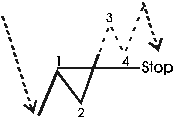 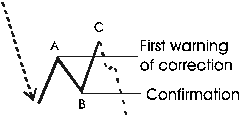 The pattern can be an impulse only if the 4th wave does not overlap the first, a level indicated by the horizontal "stop" line. As soon as the price drops under this line- before wave 5 has been completed- you have your first signal of a pending correction (picture above at the right). This correction will be confirmed when the price drops under the origin of wave C, which is the end of wave B. Provided it doesn?t drop under the "confirmation" line, it could still be an extended 3rd wave that subdivides. In that case the C or 3 wave is only wave 1 of the third wave! You will find the pattern called extension under the chapter "Patterns". Practice Now we will try to apply the theory above in practice, step by step. 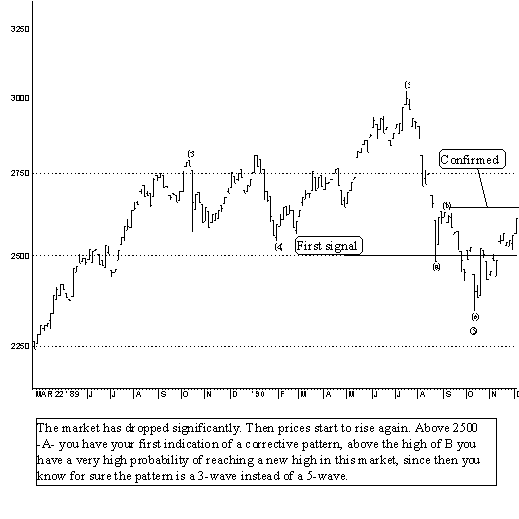 In the previous graph you have already recognized a structure consisting of three waves. Because there are three waves, we are dealing with a correction, which is a movement against the trend. Therefore the long-term trend is up and a new high will be reached. Underneath will be shown what happened next. Basically there are two scenarios which could develop. Firstly the correction could be terminated at point C and (2), finishing a Single Zigzag. Secondly a Flat or Expanded Flat could be developing. Then this market at the minimum will reach its high in a 3-wave structure, decline again to approximately point C and (2). Thereafter the larger uptrend will resume and the market will reach uncharted territory. With the above in mind it is crucial to determine if the rise will have the form of a 3 wave or a 5 wave. Let?s take a look at the picture:  To conclude, let?s take a look at the following price action: 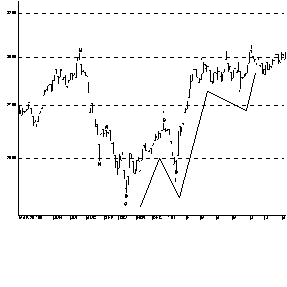
By just looking at its form- the pattern has no overlap, you can tell this definitely is a 5 wave, not a 3 wave and indeed it reached the old high at 3000. This 5- wave is the first wave of a larger wave degree, also composed of five waves. Therefore a minimal price increase of 25% (the same as wave 1) for the larger wave 3 can be calculated, which projects a target of approximately 4000. Since the above chart displays the price action of the Dow Jones, we all know what happened. The market corrected a bit, accelerated again and met a major resistance at 4000 as the following picture demonstrates. Around 4000 again a correction developed, indicating that the main trend was still up and projecting even higher targets. The same patterns evolve over and over again, enabling you to forecast the markets and explain what happened afterwards. 
|
| | | |
|
|
| 4. Simple, but effective trading strategy :: top :: |
|
| | |
|
|
|
| Since all patterns or their sub patterns are either 3 wave or 5 wave structures, it follows that at the minimum always three waves will occur, no matter what happens. Therefore if you concentrate on the 3rd wave, which will be a wave 3 in an impulse or wave C in a correction, you have a strong probability of making a profit. The charts in the following pictures give an example of this strategy in a rising, as well as a declining market. 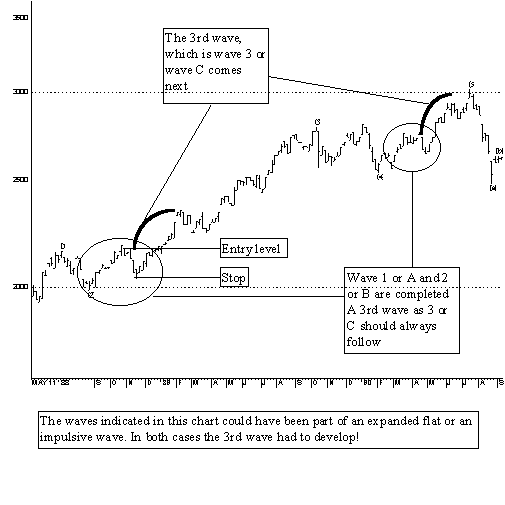  | |